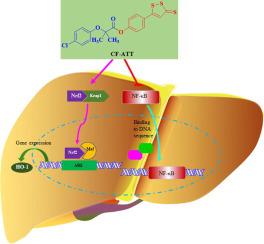Bioorganic & Medicinal Chemistry Letters ( IF 2.5 ) Pub Date : 2022-06-10 , DOI: 10.1016/j.bmcl.2022.128844 Haitao Liu 1 , Panpan Zhang 1 , Xiaoxiao Ge 1 , Qiong Wu 1 , Chuchu Han 1 , Linyang Zhang 1 , Yuxin Hua 1 , Yuxuan Zhang 1 , Jiping Liu 2 , Yongheng Shi 2 , Bin Wang 2 , Xiaoping Wang 1 , Wei Wang 1 , Yi Jiang 1 , Huawei Zhang 1 , Chong Deng 1 , Yundong Xie 1 , Ying Liu 3 , Shipeng He 3

|
Oxidative stress and inflammation were considered to be the major mechanisms in liver damage caused by clofibrate (CF). In order to obtain lipid-lowering drugs with less liver damage, the structure of clofibrate was optimized by O-desmethyl anetholtrithione and got the target compound clofibrate-O-desmethyl anetholtrithione (CF-ATT). CF-ATT significantly reduced the levels of plasma triglycerides (TG), total cholesterol (TC) in hyperlipidemia mice induced by Triton WR-1339. In addition, CF-ATT has a significantly protective effect on the liver compared with CF. The liver weight and liver coefficient were reduced. The hepatic function indexes were also decreased, such as aspartate aminotransferase (AST), alanine aminotransferase (ALT), and alkaline phosphatase (ALP). Histopathological examination of the liver revealed that inflammatory cell infiltration, nuclear degeneration, cytoplasmic loosening and hepatocyte necrosis were ameliorated by administration with CF-ATT. The hepatoprotective mechanism showed that CF-ATT significantly up-regulated Nrf2 and HO-1 protein expression and down-regulated p-NF-κB P65 expression in the liver. CF-ATT has obviously antioxidant and anti-inflammatory activity. These findings suggested that CF-ATT has significant hypolipidemia activity and exact hepatoprotective effect possibly through the Nrf2/NF-κB-mediated signal pathway.
中文翻译:

O-去甲基茴香脑三硫酮优化氯贝特导致一种具有保肝作用的新型降血脂化合物
氧化应激和炎症被认为是氯贝特(CF)引起的肝损伤的主要机制。为了获得对肝损伤较小的降脂药物,通过O-去甲基茴香脑三硫酮对氯贝特的结构进行优化,得到目标化合物氯贝特-O-去甲基茴香脑三硫酮(CF-ATT)。CF-ATT 显着降低了 Triton WR-1339 诱导的高脂血症小鼠的血浆甘油三酯 (TG)、总胆固醇 (TC) 水平。此外,与CF相比,CF-ATT对肝脏的保护作用明显。肝脏重量和肝脏系数降低。肝功能指标也有所下降,如天冬氨酸氨基转移酶(AST)、丙氨酸氨基转移酶(ALT)和碱性磷酸酶(ALP)。肝脏的组织病理学检查显示,CF-ATT给药后炎症细胞浸润、核变性、细胞质松动和肝细胞坏死得到改善。保肝机制表明CF-ATT显着上调肝脏中Nrf2和HO-1蛋白的表达,下调p-NF-κB P65的表达。CF-ATT具有明显的抗氧化和抗炎活性。这些发现表明,CF-ATT 可能通过 Nrf2/NF-κB 介导的信号通路具有显着的降血脂活性和确切的保肝作用。保肝机制表明CF-ATT显着上调肝脏中Nrf2和HO-1蛋白的表达,下调p-NF-κB P65的表达。CF-ATT具有明显的抗氧化和抗炎活性。这些发现表明,CF-ATT 可能通过 Nrf2/NF-κB 介导的信号通路具有显着的降血脂活性和确切的保肝作用。保肝机制表明CF-ATT显着上调肝脏中Nrf2和HO-1蛋白的表达,下调p-NF-κB P65的表达。CF-ATT具有明显的抗氧化和抗炎活性。这些发现表明,CF-ATT 可能通过 Nrf2/NF-κB 介导的信号通路具有显着的降血脂活性和确切的保肝作用。














































 京公网安备 11010802027423号
京公网安备 11010802027423号